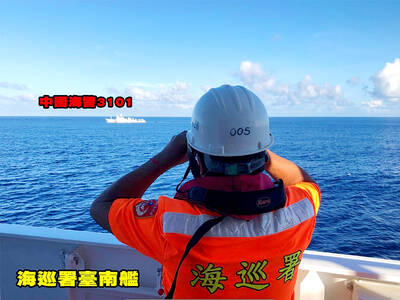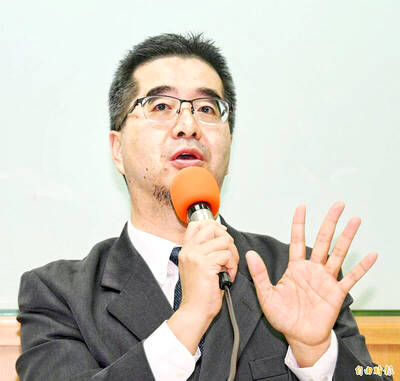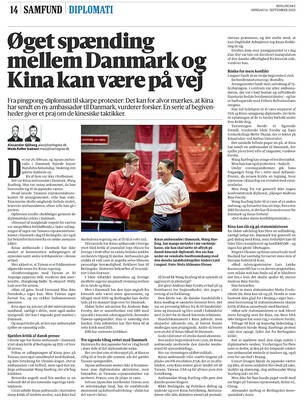Two newborns with severe enterovirus complications were hospitalized last week, while a new case of melioidosis and five cases of leptospirosis were reported after heavy rainfall from a typhoon last month, the Centers for Disease Control (CDC) said yesterday.
Hospitals reported 7,291 visits for enterovirus last week, below the epidemic threshold, CDC Epidemic Intelligence Center Director Guo Hung-wei (郭宏偉) said.
Thirteen enterovirus cases with severe complications, including seven deaths, have been reported so far this year, the highest for the same period in six years, he said.

Photo: CNA
Eleven of the cases, including the newborns, were infected with echovirus 11, which remains the dominant strain over the past four weeks, Guo said.
One of the infants, born in the middle of last month, had been hospitalized for jaundice, but still showed a loss of appetite after returning home, CDC physician Lin Yung-ching (林詠青) said.
Four days later, the boy was rushed to a hospital with a rapid heartbeat and low blood oxygen levels, and was admitted to an intensive care unit (ICU) with abnormal liver function tests, a low blood platelet count and a coagulation disorder, he said.
The child is still in the ICU, Lin said, adding that the mother had upper respiratory symptoms before giving birth and the father had a fever at the time, indicating that the baby might have been infected by them.
The mother of the other case, born late last month, had a fever and sore throat before giving birth, so the baby was placed in an isolated nursery room immediately after birth and observed for four days before returning home, he said.
However, she began having rashes and sleepiness the next day, and later developed a loss of appetite, decreased vitality and jaundice, he said, adding that the girl is an ICU for suspected symptoms of sepsis.
Although enterovirus has not entered an epidemic period and most cases are mild, a few might rapidly progress into severe illness, so caregivers of infants should pay special attention to signs of severe illness and seek medical attention as soon as possible, CDC Deputy Director-General Tseng Shu-hui (曾淑慧) said.
A new case of melioidosis and five cases of leptospirosis were reported last week, as well as a death related to a previously confirmed melioidosis case, Guo said.
The new melioidosis case is a woman in her 80s in central Taiwan, who has hypertension and diabetes, and was not directly exposed to flood water or mud, Lin said.
She was hospitalized in an ICU after falling unconscious earlier this month, and tested positive for Burkholderia pseudomallei, the bacteria that causes melioidosis, he said.
The five leptospirosis cases include two in southern Taiwan and three in central Taiwan, he said.
Four of them work in environments where livestock are butchered or sold, including two places where rats were found, and one of the people had direct exposure to flood water and mud, he said.
All of them were discharged from hospitals after treatment, he added.
People should wear masks, gloves, long boots and other protective clothing when cleaning up flooded environments, or areas that could have been contaminated by animal urine or feces, and wash their hands thoroughly with soap afterward to prevent infection, Tseng said.
They should also tell their doctor about any direct contact with floodwater, mud or animals when seeking medical attention for a fever and other suspected symptoms, she added.

The Coast Guard Administration (CGA) yesterday said it had deployed patrol vessels to expel a China Coast Guard ship and a Chinese fishing boat near Pratas Island (Dongsha Island, 東沙群島) in the South China Sea. The China Coast Guard vessel was 28 nautical miles (52km) northeast of Pratas at 6:15am on Thursday, approaching the island’s restricted waters, which extend 24 nautical miles from its shoreline, the CGA’s Dongsha-Nansha Branch said in a statement. The Tainan, a 2,000-tonne cutter, was deployed by the CGA to shadow the Chinese ship, which left the area at 2:39pm on Friday, the statement said. At 6:31pm on Friday,

The Chinese People’s Liberation Army Navy’s (PLAN) third aircraft carrier, the Fujian, would pose a steep challenge to Taiwan’s ability to defend itself against a full-scale invasion, a defense expert said yesterday. Institute of National Defense and Security Research analyst Chieh Chung (揭仲) made the comment hours after the PLAN confirmed the carrier recently passed through the Taiwan Strait to conduct “scientific research tests and training missions” in the South China Sea. China has two carriers in operation — the Liaoning and the Shandong — with the Fujian undergoing sea trials. Although the PLAN needs time to train the Fujian’s air wing and

The American Institute in Taiwan (AIT) put Taiwan in danger, Ma Ying-jeou Foundation director Hsiao Hsu-tsen (蕭旭岑) said yesterday, hours after the de facto US embassy said that Beijing had misinterpreted World War II-era documents to isolate Taiwan. The AIT’s comments harmed the Republic of China’s (ROC) national interests and contradicted a part of the “six assurances” stipulating that the US would not change its official position on Taiwan’s sovereignty, Hsiao said. The “six assurances,” which were given by then-US president Ronald Reagan to Taiwan in 1982, say that Washington would not set a date for ending arm sales to Taiwan, consult

A Taiwanese academic yesterday said that Chinese Ambassador to Denmark Wang Xuefeng (王雪峰) disrespected Denmark and Japan when he earlier this year allegedly asked Japan’s embassy to make Taiwan’s representatives leave an event in Copenhagen. The Danish-language Berlingske on Sunday reported the incident in an article with the headline “The emperor’s birthday ended in drama in Copenhagen: More conflict may be on the way between Denmark and China.” It said that on Feb. 26, the Japanese embassy in Denmark held an event for Japanese Emperor Naruhito’s birthday, with about 200 guests in attendance, including representatives from Taiwan. After addressing the Japanese hosts, Wang